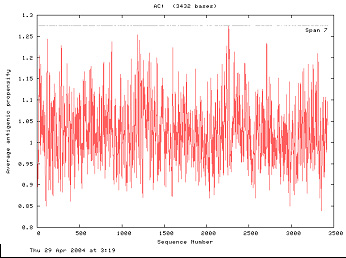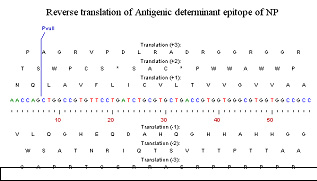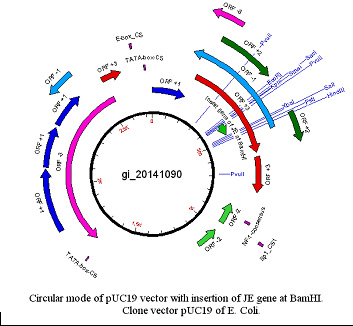|
BIOINFORMATICS BASED VECTOR DESIGNING TO IDENTIFY AND TARGET FOR EXPRESSION OF NUCLEOCAPSID PROTEIN REGION FROM JAPANESE ENCEPHALITIS VIRUS. |
|
|
V. S. Gomase |
|
|
Oral free paper |
|
|
Abstract |
|
|
In the treatment of Japanese encephalitis disease state patients are suffering from various adverse reaction and contraindications also limitation of therapy for the same. One of the major treatments is gene therapy or recombinant DNA vaccines involve targeting multiple antigenic component of virus to direct and empower the immune system to protect the host from viral infection. B-cell epitopes on JEV nucleocapsid protein are important determinants of protection against virus infection. As our knowledge of the immune responses to a protein antigen progressed, it became clear that the whole protein was not necessary for raising the immune response, but small segments of protein called the antigenic determinants or the epitopes (NQLAVFLICVLTVVGVVAA, 2254-2272 from Nucleocapsid Protein of JEV) were sufficient for eliciting the desired immune response. A peptide insert into plasmid vector of E.COLI i.e. pUC19 vector using bioinformatics tool (DS Gene 1.5 Accelrys Software). Thus, to improve chances of producing anti-peptide antibodies capable of recognizing JEV nucleocapsid protein. Immunization cassettes should be capable of immunizing of broad immunity against both humoral and cellular epitope thus giving vaccines the maximum ability to deal with viral immune escape. We theorized that a successful immunization strategy against Japanese Encephalitis infection could also involved a combination of such DNA vaccine cassettes. DNA immunization hold grate promise for providing safe and inexpensive vaccine for many infectious pathogens, including Japanese encephalitis. |
|
|
Keywords - Viral Vector, MCS, Antigenic sites, Immune response, DNA Vaccine. |
|
|
Introduction |
|
|
Japanese encephalitis (JE) is an acute viral infection of the central nervous system. Disease normally occur in large numbers in many Asian countries, including Cambodia, China, India, Korea, Myanmar, Philippines, Nepal, Sri Lanka, Thailand and Vietnam. The annual incidence of clinical infection in endemic areas ranges from 10-100 per 100,000 populations. Approximately 3 billion people and 60% of the world's population live in endemic regions and about 50,000 JE cases are notified annually. Mortality happen in JE infection is 10,000. The vast majority of JE infections are in apparent and only one in 25-1000 infections results in symptomatic illness. The principal clinical manifestation of illness is encephalitis. |
|
|
JEV infection of host cells produces three structural and seven nonstructural proteins. One of these, the nucleocapsid protein, is the major protein of the virion. This protein is believed to play an important role in a number of processes, including viral attachment, membrane fusion, and entry into the host cell. In response to JEV infection, the host produces virus neutralizing antibodies and cytotoxic T cells (CTLs). The principal target for the neutralizing antibodies is the nucleocapsid protein. It has been shown that protection against JEV infection is mainly antibody dependent, and virus-neutralizing antibodies alone are sufficient to impart protection (Konishi, E., M. Yamaoka, W. Khin-Sane, I. Kurane, K. Takada, and P. W. Mason. 1999, Pan, C., H. Chen, H. Huang, and M. Tao. 2001.). Peptide(s) from JEV E protein that forms the virus-neutralizing epitope(s) could, therefore, be used for inducing JEV-neutralizing antibodies. |
|
|
DNA Vaccines |
|
|
"DNA vaccines is The Third Vaccine Revolution" |
|
|
The deliberate introduction of a DNA plasmid carrying a protein-coding gene that transfects cells in vivo at very low efficiency and expresses an antigen that causes an immune response. These are often called DNA vaccines but would better be called DNA-mediated or DNA-based immunization since it is not the purpose to raise antibodies against the DNA molecules themselves. The plasmid DNA is taken up by muscle cells after intramuscular injection. It has also be shown that DNA can be introduced into tissues by bombarding the skin with DNA-coated gold particles. It is also possible to introduce DNA into nasal tissue in nose drops. In the case of the gold bombardment method, one nanogram of DNA coated on gold produced an immune response. One microgram of DNA could potentially introduce a thousand different genes into the vaccine. |
|
|
Possible Problems |
|
|
|
|
Advantages of DNA vaccines |
|
|
|
|
All of the above means that DNA vaccines are cheap and therefore likely to be developed against pathogens of lesser economic importance (at least to drug companies) |
|
|
Materials and Methods |
|
|
Sequence Retrieval |
|
|
The sequence details of nucleocapsid Protein of Japanese encephalitis were retrieved from the GenBank Database using protein database. NCBI Reference Sequences : AAA46248. |
|
|
Prediction of antigenic peptides - |
|
|
This program predicts those segments from within a nucleocapsid protein sequence that are likely to be antigenic by eliciting an antibody response. |
|
|
Antigenic peptides are determined using the method of Kolaskar and Tongaonkar (1990). Predictions are based on a table that reflects the occurrence of amino acid residues in experimentally known segmental epitopes. Segments are only reported if the have a minimum size of 8 residues. The reported accuracy of method is about 75%. |
|
|
Method specification - |
|
|
Program - Prediction Antigenic peptides |
|
|
Method - Antigen prediction. |
|
|
Protein sequence - Nucleocapsid protein (JE virus). |
|
|
Format - FASTA. |
|
|
Website - http://www.mifoundation.org/ |
|
|
Reverse Translation |
|
|
Use Reverse Translation was performing using DS-gene1.5 (Accelrys software), To generate a nucleotide sequence from an amino acid sequence of antigenic determinant site. You specify the sequence to be translated and the genetic code to be used. |
|
|
Vector Sequence Retrieval - |
|
|
The sequence details of pUC19 of E-coli were retrieved from the GenBank Database using nucleotide database. NCBI Reference Sequences : ACCESSION L09137 X02514. |
|
|
Restriction Enzyme Analysis |
|
|
Experiments to determine the efficiency of cleavage close to the DNA fragment ends for restriction endonucleases cleaving pUC19 MCS were performed as using DS-gene1.5 (Accelrys software). |
|
|
Cloning into Plasmids |
|
|
pUC19 DNA is recombined with other DNA. By inserting a linear piece of antigenic determinant epitope of nucleocapsid protein from Japanese encephalitis virus into the Multiple Cloning Site (MCS) of the plasmid vector pUC19, the inserted DNA interrupts the coding region. |
|
|
Results and Interpretation - |
|
|
JEV infection in a host produces both the virus-neutralizing antibodies. It has, however, been shown that protection against JEV is mainly antibody dependent and that virus-neutralizing anti-bodies alone are sufficient to impart protection. This is also evident from the fact that the formalin-inactivated JEV vaccine, which does not induce CTLs (Kaur R., G. Sachdeva, and S.Vrati. 2002), provides protection to vaccines against JEV. It therefore appears that the B-cell epitopes on JEV nucleocapsid protein are important determinants of protection against virus infection. As our knowledge of the immune responses to a protein antigen progressed, it became clear that the whole protein was not necessary for raising the immune response, but small segments of protein called the antigenic determinants or the epitopes (NQLAVFLICVLTVVGVVAA, 2254-2272) were sufficient for eliciting the desired immune response. |
|
|
PREDICTION OF ANTIGENIC PEPTIDES - |
|
|
|
|
|
|
|
Figure 1 - Antigenic determinant plot. X-axis contains sequence number and y-axis contain average antigenic propensity. |
|
|
There are 138 antigenic determinants in sequence. The highest pick at start position -2254 to 2272. The sequence is- NQLAVFLICVLTVVGVVAA. The average for the whole protein is above 1.0 then all residues having above 1.0 are potentially antigenic. |
|
|
The highest pick sequence of antigenic determinant site is used for insertion at the multiple cloning vectors. Highest pick in antigenic determinants plot indicate antigenic site for the host cell attachments. This sequence is inserted into the multiple cloning site of cloning vectors, gives new synthetic clone vector, which is used as synthetic peptide vaccines. Various software tools and web tools used for the construction of cloning vectors. We can insert- this amino acid sequence "NQLAVFLICVLTVVGVVAA". |
|
|
Specificity - |
|
|
|
|
Reverse Translation |
|
|
Properties of antigenic epitope of the nucleocapsid protein of JE virus. |
|
|
According to Chou Fasman Plot, sequence "NQLAVFLICVLTVVGVVAA" shows Beta-sheet region. According to Robson Garnier Plot, sequence NQLAVFLICVLTVVGVVAA" shows Beta-sheet region. Sequence "NQLAVFLICVLTVVGVVAA" is hydrophobic in nature. According to Von Heijne transmembrane graph, Sequence "NQLAVFLICVLTVVGVVAA" having scored greater than -0.500 is upto 0.5. According to Argos helix transmembrane graph, Sequence "NQLAVFLICVLTVVGVVAA" having scored greater than 0.800. |
|
|
Design a DNA sequence, which code for protein. |
|
|
|
|
|
Figure. 2 - Reverse Translation of Antigenic site sequence. |
|
|
It is method for design a DNA sequence that code for protein. It is useful site for the Peptide antigen design principles, can be used to help ensure production of successful antibodies. |
|
|
Enzyme location - |
|
|
|
|
|
Figure 3 - Polylinker site of pUC19 vector of E.Coli. |
|
|
It contain restriction enzyme list with cutting position in a sequence. It also called as Multiple Cloning Site of pUC19 vector. Restriction enzymes cut the sequence of pUC19 vector of E. coli, from nucleotide no.-396 to 452. |
|
|
Cloning into Plasmids |
|
|
Sequence of pUC19 vector with insertion of JE gene at site of MCS. Sequence of clone pUC19 vector at BamHI Restriction Enzymes of MCS site. This pastes the copied backtranslated antigenic site sequence of nucleocapsid protein (2254 to 2272.) containing sequence into pUC19 at the BamHI cut site at position 418 of pUC19 vector. |
|
|
Note that the pasted sequence remains highlighted. It was form new recombinant clone vector of E.Coli. |
|
|
|
|
|
Figure 4 - Circular mode of pUC19 vector with insertion of JE gene at BamHI. |
|
|
Clone vector sequence - |
|
|
|
|
|
DISCUSSION |
|
|
To improve immunogenicity, the peptides could be chemically conjugated to a large carrier protein. However, the process of chemical conjugation is not very reproducible, and uniformity of the peptide density on the carrier protein cannot be ensured. Recent findings show that peptides presented in a particulate form result in enhanced immune responses (Lomonossoff, G. P., and J. E. Johnson. 1996). |
|
|
The conformation of the peptide is an important determinant of its immunogenicity, and it may determine whether the anti-peptide antibodies would also recognize the native protein from which the peptide was derived. A peptide insert into plasmid vector of E.COLI i.e. pUC19 vector. Thus, to improve chances of producing anti-peptide antibodies capable of recognizing JEV nucleocapsid protein. |
|
|
CONCLUSION - |
|
|
Developing successful vaccine for Japanese encephalitis will likely involved targeting multiple antigenic component of virus to direct and empower the immune system to protect the host from viral infection. DNA immunization hold grate promise for providing safe and inexpensive vaccine for many infectious pathogens, including Japanese encephalitis. The direct injection of foreign genes by genetic immunization has resulted in specific immune responses that exhibit characteristic of protective immunity against the number of infectious agent in small animal model as well as primate studies. Genetic vaccination cassettes targeting each of Japanese encephalitis genes. Such a collection of immunization cassettes should be capable of immunizing of broad immunity against both humoral and cellular epitope thus giving vaccines the maximum ability to deal with viral immune escape. Further more, the power of the genetic adjuvant coadminatration (consisting co-stimulatory molecule or cytokine genes) to dramatically direct and enhance the antigen -specific humoral and cellular immune responses induce by DNA immunogens to analogous to the potential demonstrated by the combination therapy consisting of three different antiflaviviral agent for the control of Japanese Encephalitis pathogenesis. We theorized that a successful immunization strategy against Japanese Encephalitis infection could also involved a combination of such DNA vaccine cassettes. specifically , a right "DNA expression cassettes coding for env gag/ pol, accessory protein post stimulatory molecule , cytokines may provide effective protection against one of the most feared viruses in the history of man kind." |
|
|
Acknowledgement - |
|
|
We are very highly obliged and indebted to Accelrys Software, Nonlinear Dynamic Ltd., Reliance Webword and DNAtools for their Software support, without that we could not complete our project work. |
|
|
References - |
|
A. S. Kolaskar1 and Urmila Kulkarni-Kale, Gore M.M. of bioinformatics in development of peptide vaccine. A. Beliveau, S. Leclerc, M. Rouleau and S. L. Guerin, Multiple cloning sites from mammalian expression vectors interfere with gene promoter studies in vitro Eur. J. Biochem. 261, 585±590 (1999) q FEBS 1999. Burke DS, Leake CJ. Japanese encephalitis, IN: Monath TP ed The arboviruses: epidemiology and ecology, Vol 3. CRC press, Boca Raton, FL. 3:63-92, 1988. Carey DE, Myers RM, Reuben R, Webb JKG. Japanese encephalitis in South India. A summary of recent knowledge. J Indian Med Assoc. 52:10-15, 1969. DeLaFuente A, Cisneros E, Talavera A., Restriction end-converting vectors with tandem repeated multiple cloning sites. Gene. 1994 Feb 11;139(1):83-6. |
|




